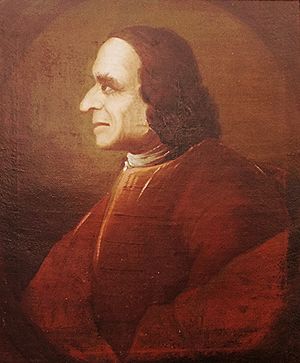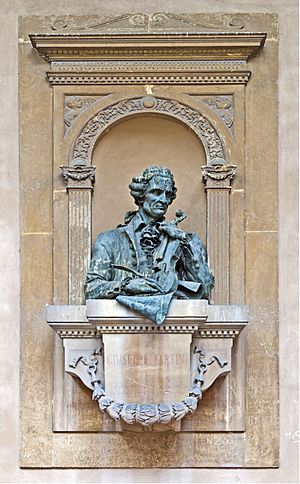Giuseppe Tartini facts for kids
Giuseppe Tartini (born April 8, 1692 – died February 26, 1770) was a famous Italian composer and violin player. He lived during the Baroque period, a time when music was often grand and decorative. He was born in a place called the Republic of Venice, which is now part of Italy.
Contents
Giuseppe Tartini's Life Story
Tartini was born in a town called Piran, which is now in Slovenia. His parents wanted him to become a Franciscan friar, which is a type of religious brother. Because of this, he started learning music early. He first studied the violin at a school in Capodistria (now Koper).
Later, he went to the University of Padua to study law. He also became very good at fencing. After his father passed away in 1710, Tartini married Elisabetta Premazore. His family didn't approve of this marriage because of her different social background. Because of this, Tartini had to leave Padua quickly and found safety in a monastery in Assisi. There, he continued his music studies.
A famous story says that in 1716, Tartini heard another violinist, Francesco Maria Veracini, play. Tartini was so amazed that he felt his own skills weren't good enough. He decided to go to Ancona and practice intensely, focusing on how to use the violin bow better.
Tartini's hard work paid off! In 1721, he became the Maestro di Cappella (which means music director) at the Basilica di Sant'Antonio in Padua. His contract allowed him to play for other places too. In Padua, he became friends with another composer, Francesco Antonio Vallotti. For a few years, from 1723 to 1725, he also worked in Prague.
Tartini was the first person to own a violin made by the super famous violin maker, Antonio Stradivari, in 1715. This violin is now known as the Lipinski Stradivarius.
In 1726, Tartini opened a violin school. Students came from all over Europe to learn from him! As he got older, Tartini became very interested in the science of music, like how sounds work together. He wrote several books about music theory, even using math to explain his ideas. He passed away in Padua.
Today, in his hometown of Piran, Slovenia, there is a statue of him in Tartini Square. One of the old buildings there is now a hotel named after him. People in Piran celebrate his birthday with a concert in the main church.
Tartini's Musical Works
Tartini's most famous piece of music is the "Devil's Trill Sonata". This piece is for a solo violin and is very hard to play, even for today's violinists. It has many difficult double stop trills (a quick back-and-forth between two notes).
There's a cool legend about how he wrote it. It's said that Tartini dreamed the Devil appeared at the foot of his bed and played the violin for him. When Tartini woke up, he tried to write down the amazing music he heard in his dream.
Most of Tartini's music is for the violin. He wrote at least 135 violin concertos (pieces for violin and orchestra) and many violin sonatas (pieces for violin, usually with piano). He also wrote some religious music, like a "Miserere" and a "Stabat Mater".
It can be tricky for music experts to figure out exactly when Tartini wrote his pieces. This is because he didn't always date his music, and he often went back and changed pieces he had already finished.
Tartini's Ideas About Music
Besides writing music, Tartini was also a music theorist. This means he studied the rules and science behind music. He is known for discovering something called "sum and difference tones." These are extra sounds you can hear when two notes are played together, especially on string instruments. This discovery helped violinists play more in tune.
He wrote about his discoveries in a book called "Trattato di musica secondo la vera scienza dell'armonia" in 1754. He also wrote a book about how to add ornaments (fancy musical decorations) to music. This book helped musicians in his time and still helps musicians today understand how his music was meant to be played.
Tartini in Stories and Books
Tartini and his "Devil's Trill Sonata" have appeared in many stories and books.
For example, Helena Blavatsky wrote a short story called "The Ensouled Violin." In this story, she talks about how people thought Tartini got his amazing musical ideas from the Devil. She even mentions the "Devil's Trill Sonata" and how Tartini himself said he wrote it after a dream where Satan played it for him.
The idea of a musician making a "deal with the devil" for musical talent is a common story. You might have heard similar tales about other musicians like Niccolò Paganini, or even in songs like "The Devil Went Down to Georgia".
Tartini's "The Devil's Trill" is also a very important part of the book The English Assassin by Daniel Silva. In this book, a main character is a famous violinist, and the sonata is featured a lot. The story of Tartini's dream is also told in the novel.
The "Devil's Trill" also appears in a Japanese anime show called Descendants of Darkness. A three-part story in the show is even named after the composition!
Images for kids
See also
 In Spanish: Giuseppe Tartini para niños
In Spanish: Giuseppe Tartini para niños





